Serving 771 students in grades Prekindergarten-5, East Milton Elementary School ranks in the bottom 50% of all schools in Florida for overall test scores (math proficiency is bottom 50%, and reading proficiency is bottom 50%).
The percentage of students achieving proficiency in math is 45% (which is lower than the Florida state average of 52%). The percentage of students achieving proficiency in reading/language arts is 49% (which is lower than the Florida state average of 52%).
The student:teacher ratio of 13:1 is lower than the Florida state level of 17:1.
Minority enrollment is 21% of the student body (majority Hispanic), which is lower than the Florida state average of 65% (majority Hispanic).
Quick Stats (2025)
- Grades: Prekindergarten-5
- Enrollment: 771 students
- Student:Teacher Ratio: 13:1
- Minority Enrollment: 21%
- Overall Testing Rank: Bottom 50% in FL
- Math Proficiency: 45% (Btm 50%)
- Reading Proficiency: 49% (Btm 50%)
- Science Proficiency: 30-34% (Btm 50%)
- Source: National Center for Education Statistics (NCES), FL Dept. of Education
School Overview
East Milton Elementary School's student population of 771 students has grown by 9% over five school years.
The teacher population of 59 teachers has stayed relatively flat over five school years.
Grades Offered
Grades Prekindergarten-5
Total Students
771 students
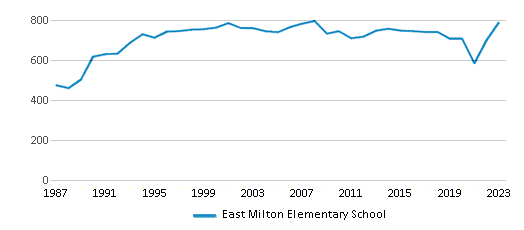
Gender %
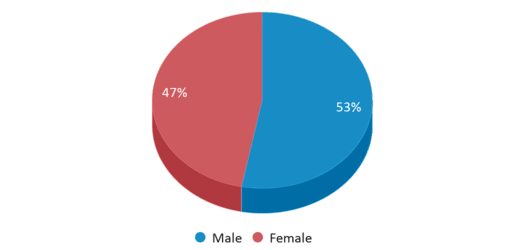
Total Classroom Teachers
59 teachers
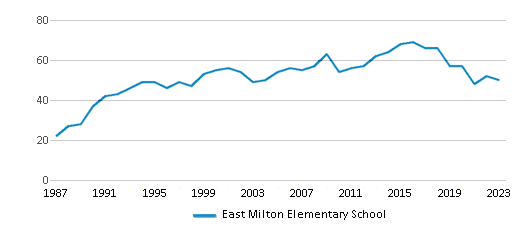
Students by Grade
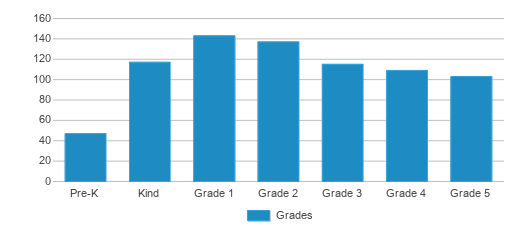
School Calendar
School Rankings
East Milton Elementary School ranks within the bottom 50% of all 3,704 schools in Florida (based off of combined math and reading proficiency testing data).
The diversity score of East Milton Elementary School is 0.37, which is less than the diversity score at state average of 0.70. The school's diversity has stayed relatively flat over five school years.
Overall Testing Rank
#2130 out of 3704 schools
(Bottom 50%)
(Bottom 50%)
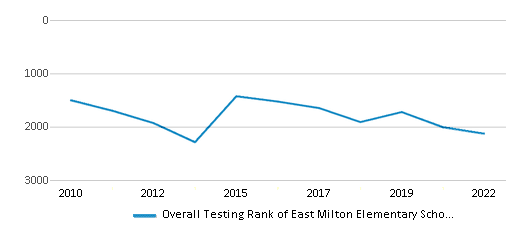
Math Test Scores (% Proficient)
45%
52%
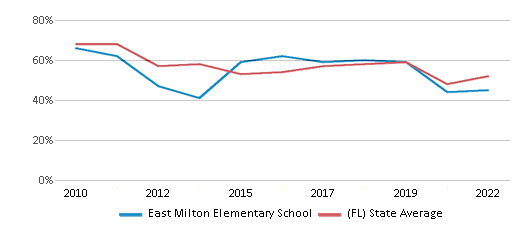
Reading/Language Arts Test Scores (% Proficient)
49%
52%

Science Test Scores (% Proficient)
30-34%
52%
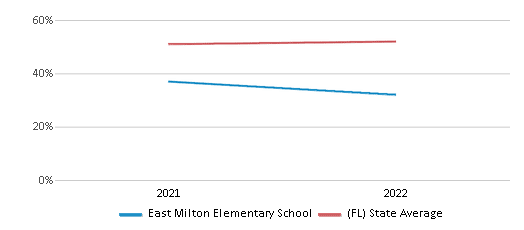
Student : Teacher Ratio
13:1
17:1
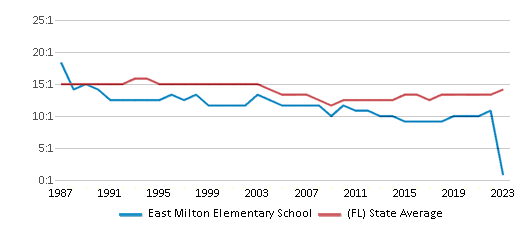
American Indian
n/a
n/a
Asian
1%
3%
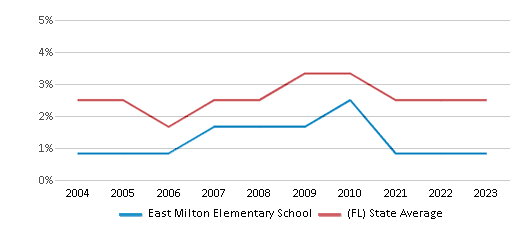
Hispanic
7%
37%
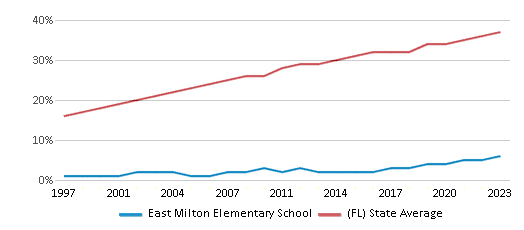
Black
5%
21%
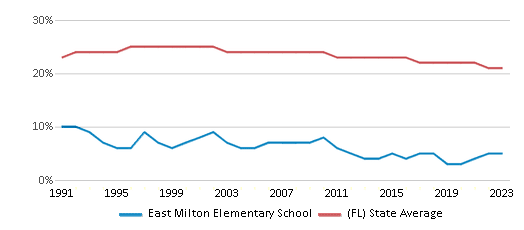
White
79%
35%
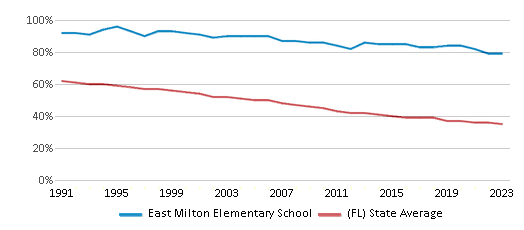
Hawaiian
n/a
n/a
Two or more races
8%
4%
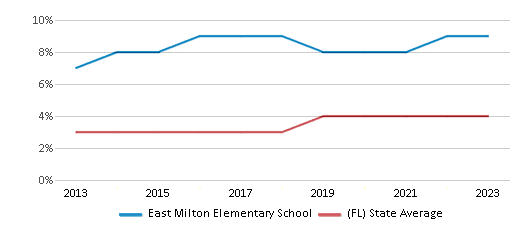
All Ethnic Groups
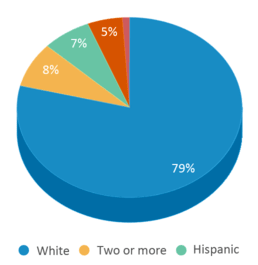
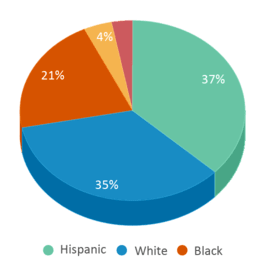
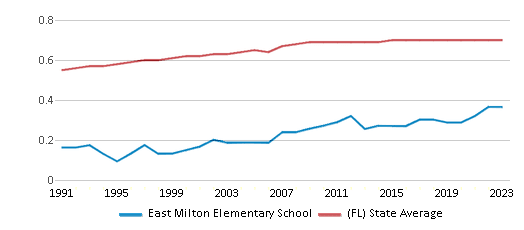
Participates in the National School Lunch Program (NSLP)
Yes
Eligible for Free Lunch
69%
47%
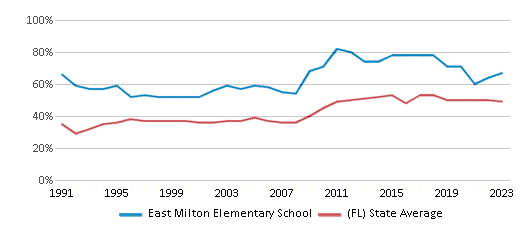
Eligible for Reduced Lunch
8%
4%
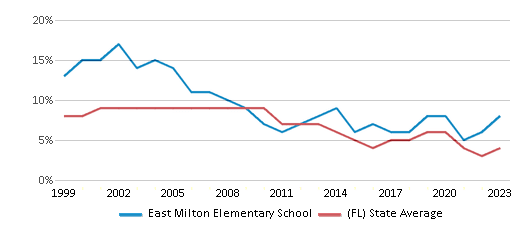
School Statewide Testing
School District Name
Source: National Center for Education Statistics (NCES), FL Dept. of Education
Profile last updated: 02/09/2025
Frequently Asked Questions
What is East Milton Elementary School's ranking?
East Milton Elementary School is ranked #2130 out of 3,704 schools, which ranks it among the bottom 50% of public schools in Florida.
What percent of students have achieved state testing proficiency in math and reading?
45% of students have achieved math proficiency (compared to the 52% FL state average), while 49% of students have achieved reading proficiency (compared to the 52% FL state average).
How many students attend East Milton Elementary School?
771 students attend East Milton Elementary School.
What is the racial composition of the student body?
79% of East Milton Elementary School students are White, 8% of students are Two or more races, 7% of students are Hispanic, 5% of students are Black, and 1% of students are Asian.
What is the student:teacher ratio of East Milton Elementary School?
East Milton Elementary School has a student ration of 13:1, which is lower than the Florida state average of 17:1.
What grades does East Milton Elementary School offer ?
East Milton Elementary School offers enrollment in grades Prekindergarten-5
What school district is East Milton Elementary School part of?
East Milton Elementary School is part of Santa Rosa School District.
School Reviews
5 11/15/2012
My oldest graduated from EME & my youngest start there in 2012. It is a wonderful school & everyone there has great concern for the parents & their children.
2 1/25/2011
I went to this school for the fourth grade, and only the fourth grade for a reason back in 1998. East Milton, strives to meet the hallmark of higher standards at any means necessary and there as students with learning disabilities are left behind. Teachers have the I am right, never wrong attitude (which is par for the course for 60% of Florida's teachers) and will mock parents. The academic programs rarely if ever sail beyond state expectations and their success is only determined by the scores of their test takers, not how their students are learning or how they are taught. The only extracurricular activities are a Recorder Club and a Chorus Group and selection is based upon test scores and academic standing rather than talent, these groups meet once a week with one or two concerts a year. There are no academic or athletic awards as teams and groups for such are only a permanent fixture in High Schools in Santa Rosa County. The facilities have improved however, students are not allowed to use the newer equipment. Parent involvement varies from class to class and student to student. The Faculty and the Staff react the same when a parent wants to get involved in their child's academic life: repulsion, conceitedness, and bothered. Which leads me to believe that both groups discourage parent involvement outside of volunteering to help out. I wouldn't send my child to this school even if it means I have to drive out to Pea Ridge Elementary or home school them.
Review East Milton Elementary School. Reviews should be a few sentences in length. Please include any comments on:
- Quality of academic programs, teachers, and facilities
- Availability of music, art, sports and other extracurricular activities
Recent Articles

What Is A Charter School?
Explore the world of charter schools in this comprehensive guide. Learn about their history, how they operate, and the pros and cons of this educational innovation. Discover key facts about charter schools, including admission policies, demographics, and funding, as well as what to look for when considering a charter school for your child.

10 Reasons Why High School Sports Benefit Students
Discover the 10 compelling reasons why high school sports are beneficial for students. This comprehensive article explores how athletics enhance academic performance, foster personal growth, and develop crucial life skills. From improved fitness and time management to leadership development and community representation, learn why participating in high school sports can be a game-changer for students' overall success and well-being.

February 05, 2025
Understanding the U.S. Department of Education: Structure, Impact, and EvolutionWe explore how the Department of Education shapes American education, from its cabinet-level leadership to its impact on millions of students, written for general audiences seeking clarity on this vital institution.






